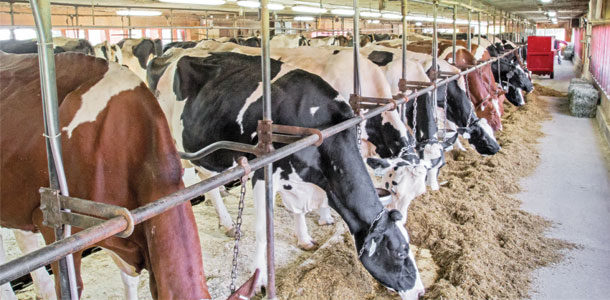Cows housed in freestalls and open lots are able to display their natural activity, and any deviations from that activity can be detected easily.
Yet there remains a significant portion of the dairy industry that also wants to utilize this technology – but their housing method has its limitations.
“Tiestall producers want to use the same electronic aids as freestall herds to help increase pregnancy rates,” Mark Carson, reproductive solutions manager for EastGen, says. “They want the ability to monitor activity and health electronically so they have a consistent method of measuring changes within their cows. Tiestall producers also want the 24-hour coverage so they can see the cows that only show heat for eight hours.”
Due to the limited activity of cows in a tiestall or stanchion barn, it is more difficult to detect heat in these environments.
Udi Golan, senior product manager for AfiMilk, explains, “Since the animals do not interact, the herdsman is forced to use less reliable secondary signs to determine which cows are in heat, such as mucus discharge, swelling and reddening of the vulva or general restless behaviour.
Although milkers are around their tied cows to see signs of heat twice daily during milking, depending on the expertise of personnel, the overall detection rate and breeding risk in stanchion environments is quite poor.”
Tiestall and stanchion farms continue to use visual heat detection as well as timed A.I. to address their herds’ reproductive needs. However, both AfiMilk and EastGen are making activity-monitoring systems available to tiestall and stanchion dairies in Canada.
AfiMilk’s AfiAct II Stanchion incorporates long-range data collection, reading leg-mounted behaviour monitoring tags throughout the stanchion barn. Heat alerts are then plotted as a breeding list on the farm computer or sent as heat indications to the producer’s cell phone.
“The breakthrough in this system is a unique algorithm we developed taking into account multiple animal behaviour measurements (activity, rest, restlessness etc.),” Golan says. “For the first time, we have been able to filter out behaviour patterns of tied cows, which are highly correlated to heat status.”
The algorithm and unique heat indicator parameter are the results of a long-term research effort performed in commercial farms in Canada, Germany, Italy and Poland. To date, the system has been installed on 11 commercial dairies worldwide, including four Canadian farms.
“Statistics from the adopters of the system show that the number of confirmed heat events identified by the system more than doubled compared to the period prior to using the automatic detection system.
The number of cows missed by [the activity system] but detected by the operator with visual inspection was almost none, while a significant number of animals were bred based solely on the detection of the automated system,” Golan reports.
Joel Stam, owner of Eagle Lee Farm in Norwich, Ontario, says, “AFI has raised the level of our breeding program from a guessing game to a science. Used as a tool, in addition to traditional methods, we have achieved fewer than 5 percent open cows on herd health in the last four months.”
EastGen reports it is in the early adaption stage of implementing its Heatime system in tiestall and stanchion barns. “We have herds that have added activity monitoring to their dairy barn successfully over the past year.
The farms have been using activity and rumination monitoring to look for changes within the cows. It helps find cows in heat, as well as changes in the cows’ health, such as cases of mastitis and DAs before they go clinical,” Carson says.
Janet Ringelberg started using this system on her 60-cow tiestall dairy near Troy, Ontario, nearly one year ago. Previously, she was using visual heat detection, along with heat detection patches to a small extent on her Holstein cows and heifers.
Now, a wireless reader is mounted in the back of the milking barn to collect the activity recorded from each collar device worn by animals in the tiestall barn, out on pasture and in the standalone heifer barn nearby. That data is sent to a monitor in the milk house and can also be read on Ringelberg’s laptop.
“The monitor in the milk house is the first and last thing we look at in the barn to see which cows were flagged on the heat and health reports,” she says.
Since implementing the system, Ringelberg says she rarely has cows bred two days in a row. “Now we can watch for cows peaking and can see the optimum time for breeding. Our timing of A.I. has improved and we are using less hormones, roughly half of what we used to on cows we didn’t catch in heat.”
Her cows spend time outdoors in the summer and are kept inside during the winter. Last year, she lowered the threshold on the system for the winter months and decided to keep it there for the entire year. “I’d rather have the system flag a cow falsely and have to check them than to miss one,” Ringelberg comments.
With a lower threshold, she says it is important to be aware of activities on the farm such as pen moves or the first few days out on pasture. “It’s a great tool to aid in heat detection,” she says, but notes it doesn’t negate good cowside monitoring by farm managers.
When considering the system, Ringelberg says Carson informed her the farm was doing well reproductively and they may not see large changes in their herd statistics. Still, she says the farm’s pregnancy rate improved 1 percent in the first six months, and the farm’s A.I. bill has decreased.
Golan claims owners of tiestall facilities have an opportunity to improve their herd’s fertility performance substantially. Pregnancy rates can increase between 6 percent and 9 percent compared to visual observation, and a reduction of 20 to 40 days open per cow in the herd when combined with synchronization protocols is expected. “As a result, a tiestall farm with 100 cows may expect to save between $10,000 and $17,000 per year,” he says.
As these new systems enter the marketplace, Carson is confident they too will see the same growth recognized within freestall herds. He says, “It is my belief that every cow in Canada will be wearing an electronic monitoring device within the next 10 years. The ability to monitor changes in cows is valuable information dairymen will want to have in managing cows day-to-day. As well, electronic monitoring will grow across all dairies to help satisfy consumer demand for less intervention with timed A.I. to get cows pregnant.” PD









